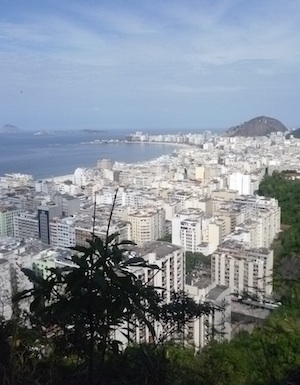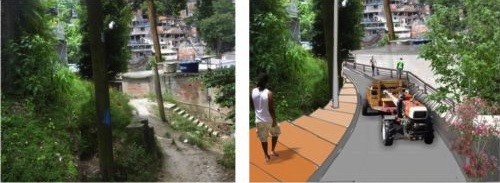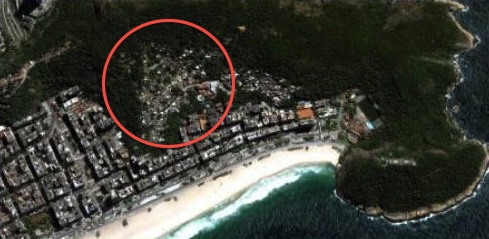 August 22, 2011—As I climbed Morro da Babilônia, up the Leme hillside overlooking Copacabana, I was taken aback by this community’s sheer beauty. Unlike many of the favelas here in Rio, Babilônia sports wide, paved roads with trees lining the walk and scenery that stopped me dead in my tracks. As my friend and I made our way up to meet with the director of Babilônia’s reforestation cooperative, CoopBabilônia, we both agreed that this would be a community both of us would be happy to call home.
August 22, 2011—As I climbed Morro da Babilônia, up the Leme hillside overlooking Copacabana, I was taken aback by this community’s sheer beauty. Unlike many of the favelas here in Rio, Babilônia sports wide, paved roads with trees lining the walk and scenery that stopped me dead in my tracks. As my friend and I made our way up to meet with the director of Babilônia’s reforestation cooperative, CoopBabilônia, we both agreed that this would be a community both of us would be happy to call home.
Like many other communities here, Babilônia has been assigned by the city of Rio de Janeiro to the Morar Carioca project. With the slogan ‘One city for all,’ the project aims to integrate Rio’s formal and informal neighborhoods.
When we interviewed Cesar, the coop’s director, he explained that Morar Carioca has been welcomed by a majority of residents. According to the pamphlet detailing the project’s implementation, Babilônia will recieve 14,501 m2 of paved roads, a brand new ‘motovia’ (motorcycle way) which will facilitate transportation for residents, 260 new light posts, improved water and sewage systems, and more. According to Cesar, Morar Carioca will allow the cooperative to expand its 12-year old reforestation project.
Also as part of Morar Carioca, 60 homes near the top of the community have been marked for relocation in order to establish an eco-limit and limit further expansion of the community up the hillside. They will be transferred to newly built apartment buildings at the bottom of the hill, within the community. Unlike the majority of favelas, however, Morro de Babilônia was built from the top down, making the oldest best-constructed houses those at the very top. As a result, the city-established environmental protection zone at the top of the hill will lead to the removal of the community’s oldest and most established, historical homes.
The people living in these older homes are often elderly members of the community. After having lived in the same home all their lives, many of them are being left with no choice but to accept Morar Carioca’s tiny box apartments as compensation. One home, that is nearly 100 years old and has seen a family through 3 generations is scheduled to be demolished. Yet there was no participation or consultation of residents, as would have been required.
The residents targeted for removal (approximately 10%) are upset, thus creating tension with the majority who support the Morar Carioca program entering the community.
Though not yet tackled by Babilônia’s residents, the looming threat of gentrification is already on the horizon. A hostel in the community is attracting foreign tourists who want to combine a real-life favela ‘experience,’ with the proximity to Rio’s prime beaches, all the while assuring the visual appeal and security that Babilônia can offer with its reforestation program and newly installed UPP community police force.
Out of curiosity I called about the price of a property I noticed for sale, and learned it was listed for R$2 million (US$1.25 million).
Despite all the great things that Morar Carioca has promised Babilônia, nowhere on the list is the guarantee that long-time residents will even be able to take advantage of its investments. Nowhere in the program are there provisions to guarantee that the community will remain affordable or accessible to lower income families. This, despite the program having received US$150 million from the Inter-American Development Bank to “improve living conditions in low-income neighborhoods.” The language of the Morar Carioca program always speaks of integrating neighborhoods, not their residents, into the fabric of the city. And, without policies guaranteeing existing residents can stay, it is likely integration will be accomplished via shortcut: by driving out the poorest residents.
In fact, gentrification is becoming increasingly apparent in Rio’s South Zone favelas. Take Cantagalo, located on the hill above Ipanema, an affluent neighborhood in Rio’s South Zone. When the city council made the decision to install an elevator, residents approved. This would simplify everyday tasks while integrating the community more seamlessly with the city below. But as the project developed and an enormously flashy elevator was installed, followed by tens of young foreigners seeking homes in the community in the months that followed, questions began to flow.
Without affordable housing guarantees, Morar Carioca and other upgrading programs like the federal government’s Growth Acceleration Program (PAC) may amount to a strategy to speed up gentrification in a city that is already one of the most expensive on Earth, and where demand for beachside real estate is unquenchable.
Just as it occurred to me that Babilônia would be a wonderful place to live, there is nothing stopping others, whether young middle class brazilians, or foreigners, from renting or buying a home, unintentionally driving original residents further away, into distant communities where problems would only be worse and their potential of successful integration lesser. This in a city that runs counter to Brazil’s 11-year trend in reducing income inequality. Rio’s inequality has remained the same for 17 years. Forced out migration from central and South Zone favelas will only deepen the divide.


